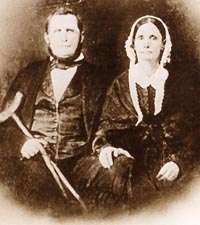John Crenshaw
| John Crenshaw | |
|---|---|
 John Crenshaw, a notorious illegal slave trader, holding a crutch, with his wife, Francine "Sina" Taylor, date unknown | |
| Born |
John Hart Crenshaw November 19, 1797 North Carolina |
| Died |
December 4, 1871 (aged 74) Hickory Hill estate, Equality, Gallatin County, Illinois |
| Resting place | Hickory Hill Cemetery, Equality, Gallatin County, Illinois |
| Nationality | American |
| Occupation | salt maker, kidnapper, illegal slave trader, slave stealer, farmer |
| Employer | self employed, family business |
| Known for | For being a landowner, salt maker, and slave trader, and slave breeder, based out of Gallatin County, Illinois. Although Illinois was a free state, Crenshaw leased the salt works, in nearby, Equality from the government, which permitted the use of slaves for the arduous labor of producing salt. Crenshaw was widely believed to be involved in the kidnapping and sale of free black people, in free states, as slaves, in the South, an enormously profitable trade, later known as, the Reverse Underground Railroad. |
| Religion | Methodist, Episcopalian |
| Spouse(s) | Francine "Sina" Taylor |
| Children | Alexander Crenshaw, Mary Hart Crenshaw Hall, Elizabeth Hart Crenshaw Lawler, Nancy Crenshaw, Margaret Taylor Crenshaw Lanphier, Julia A.W. Crenshaw Foster |
| Parent(s) | William Crenshaw and Elizabeth Crenshaw |
| Relatives | Robert Crenshaw (brother) |
John Hart Crenshaw (November 19, 1797 – December 4, 1871) was an American landowner, salt maker, and slave trader, and slave breeder, based out of Gallatin County, Illinois. Although, Illinois was a free state, Crenshaw leased the salt works, in nearby, Equality from the government, which permitted the use of slaves for the arduous labor of hauling and boiling brackish water to produce salt. Crenshaw was widely believed to be involved in the kidnapping and sale of free black people, in free states, as slaves, in the South, an enormously profitable trade, later known as the Reverse Underground Railroad. His great-great grandson was notorious Texas serial killer Joe Ball.
Illegal slave trading
Due to John Crenshaw's keeping and breeding of slaves and kidnapping of free blacks, who were then pressed into slavery, on his Hickory Hill estate, the house became popularly known as The Old Slave House and is alleged to be haunted. A grand jury indicted Crenshaw for kidnapping, once in the mid-1820s (the outcome unknown) and again in 1842 when a trial jury acquitted him. The case’s victims, Maria Adams and her seven or eight children, ended up as slaves in Texas. In 1828, Crenshaw took Frank Granger and 15 others downriver to Tipton Co., Tennessee, and sold them as slaves. Crenshaw also kidnapped Lucinda and her children in 1828. She ended up in Barren County, Kentucky. Contemporary letters identifying Crenshaw’s role back both cases. Crenshaw also kidnapped Peter White and three others in the 1840s. They were sold into slavery in Arkansas, but later rescued. Stories of strange noises upstairs coming from victims, date to 1851. Despite accounts that the rooms were slave quarters, Crenshaw family stories indicate a distinction between the plantation’s household servants and field hands, and the victim’s of Crenshaw’s criminal activities.[1][2][3][4] However, problems arose in the indicting of Crenshaw because the Fugitive Slave Act of 1850 required all northern citizens to return runaway slaves to their owners and the Dred Scott decision which stated that all blacks were property whether they were in a free or slave state.
Underground Railroad National Network to Freedom
In 2004, the National Park Service named the Crenshaw Mansion, referred to as "The Old Slave House", as part of the Underground Railroad National Network to Freedom program to acknowledge its importance in the reverse underground railroad and the role John Crenshaw played in condemning free blacks to slavery.[5][6]
See also
- Elizabeth Bathory
- Patty Cannon
- James Ford (pirate)
- Delphine LaLaurie
- La Quintrala
- Gilles de Rais
- Darya Nikolayevna Saltykova
References
- ↑ "The Old Slave House". National Park Service Network to Freedom Database. National Park Service. Retrieved May 23, 2010.
- ↑ Taylor, Troy (2008). Haunted Illinois: Ghosts and Strange Phenomena from the Prairie State. Stackpole Books.
- ↑ http://www.prairieghosts.com/slave.html
- ↑ Musgrave, Jon (2005). Slaves, Salt, Sex & Mr. Crenshaw: The Real Story of the Old Slave House and America's Reverse Underground R.R. Published=Illinoishistory.com. p. 608. ISBN 097079844X.
- ↑ "The Old Slave House." National Park Service Network to Freedom Database. National Park Service. Accessed online May 23, 2010.
- ↑ Musgrave, Jon. 2005. Slaves, Salt, Sex & Mr. Crenshaw: The Real Story of the Old Slave House and America's Reverse Underground R.R. Published by Illinoishistory.com. 608 pages.
External links
- A timeline of the Crenshaw House (pdf)
- Black Kidnappings in the Wabash and Ohio Valleys of Illinois by Jon Musgrave
This article includes public domain text from the National Park Service website